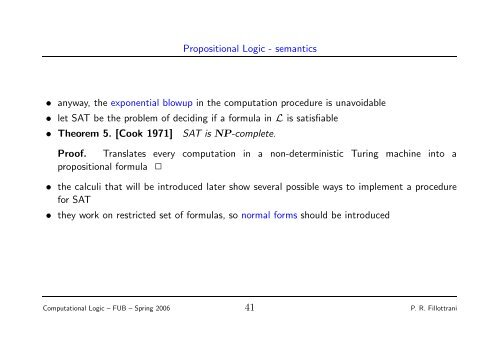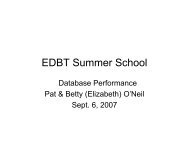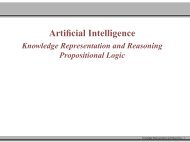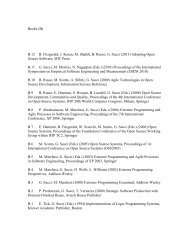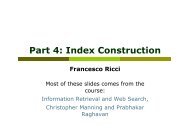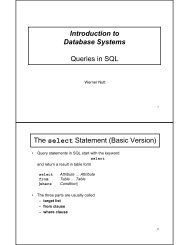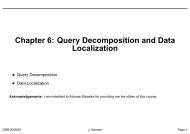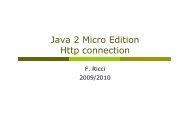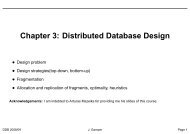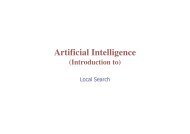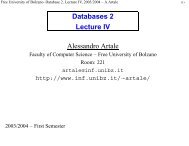Propositional Logic II
Propositional Logic II
Propositional Logic II
Create successful ePaper yourself
Turn your PDF publications into a flip-book with our unique Google optimized e-Paper software.
<strong>Propositional</strong> <strong>Logic</strong> - semantics<br />
• anyway, the exponential blowup in the computation procedure is unavoidable<br />
• let SAT be the problem of deciding if a formula in L is satisfiable<br />
• Theorem 5. [Cook 1971]<br />
SAT is NP-complete.<br />
Proof. Translates every computation in a non-deterministic Turing machine into a<br />
propositional formula ✷<br />
• the calculi that will be introduced later show several possible ways to implement a procedure<br />
for SAT<br />
• they work on restricted set of formulas, so normal forms should be introduced<br />
Computational <strong>Logic</strong> – FUB – Spring 2006 41 P. R. Fillottrani
<strong>Propositional</strong> <strong>Logic</strong> - normal forms<br />
• two formulas F and G are (semantically) equivalent iff F |= G and G |= F<br />
• it is written F ≡ G<br />
• Exercise: show that this is equivalent to saying that F ⇔ G is a tautology<br />
• let’s review some named equivalences:<br />
Computational <strong>Logic</strong> – FUB – Spring 2006 42 P. R. Fillottrani
<strong>Propositional</strong> <strong>Logic</strong> - normal forms<br />
(F ∧ F ) ≡ F ∧-idempotency<br />
(F ∨ F ) ≡ F ∨-idempotency<br />
(F ∧ G) ≡ (G ∧ F ) ∧-conmutativity<br />
(F ∨ G) ≡ (G ∨ F ) ∨-conmutativity<br />
(F ∧ (G ∧ H)) ≡ ((F ∧ G) ∧ H) ∧-associativity<br />
(F ∨ (G ∨ H)) ≡ ((F ∨ G) ∨ H) ∨-associativity<br />
(F ∧ G) ∨ F ≡ F absorption<br />
(F ∨ G) ∧ F ≡ F absorption<br />
(F ∧ (G ∨ H)) ≡ ((F ∧ G) ∨ (F ∧ H)) distributivity<br />
(F ∨ (G ∧ H)) ≡ ((F ∨ G) ∧ (F ∨ H)) distributivity<br />
¬¬F ≡ F double negation<br />
¬(F ∧ G) ≡ (¬F ∨ ¬G) de Morgan law<br />
¬(F ∨ G) ≡ (¬F ∧ ¬G) de Morgan law<br />
F ⇔ G ≡ (F ⇒ G) ∧ (G ⇒ F ) equivalence<br />
F ⇒ G ≡ (¬F ∨ G) implication<br />
Computational <strong>Logic</strong> – FUB – Spring 2006 43 P. R. Fillottrani
<strong>Propositional</strong> <strong>Logic</strong> - normal forms<br />
• if we replace a subformula G of F by a formula H then we obtain F [G\H]<br />
• Theorem 6.<br />
• Exercise: prove this theorem<br />
If G is a subformula of F , and G ≡ H then F ≡ F [G\H]<br />
• following the given equivalences, not all connectives are needed<br />
• a set of connectives is said to be necessary iff any propositional formula can be transformed<br />
into a semantically equivalent one which only contains connectives in the set<br />
• example: {¬, ∧} is a necessary set of connectives<br />
• Exercise: prove this<br />
Computational <strong>Logic</strong> – FUB – Spring 2006 44 P. R. Fillottrani
<strong>Propositional</strong> <strong>Logic</strong> - normal forms<br />
• theorem 6 and the given equivalences can be used to introduce so-called normal forms<br />
• a formula is in negation normal form iff it is built only by literals, conjunctions and disjunctions<br />
• a formula is in conjunctive normal form (CNF) iff it has the form C 1 ∧ C 2 ∧ . . . ∧ C n where<br />
each C i is a disjunction of literals<br />
• a formula is in disjunctive normal form (DNF) iff it has the form D 1 ∨ D 2 ∨ . . . ∨ D n where<br />
each D i is a conjunction of literals<br />
• C 1 ∧ C 2 ∧ . . . ∧ C n<br />
n = 0<br />
≡ C 1 ∧ C 2 ∧ . . . ∧ C n ∧ ⊤, so we can say ⊤ is in CNF taking<br />
• D 1 ∨ D 2 ∨ . . . ∨ D n ≡ D 1 ∨ D 2 ∨ . . . ∨ D n ∨ ⊥, so we can say ⊥ is in DNF taking<br />
n = 0<br />
• C i are called clauses; D i are dual clauses; set notation is generally used<br />
• factoring in clauses consists of eliminating duplicates of predicates in the same clause<br />
• it is equivalent to applying the idempotency laws, although it is implied in set notation<br />
Computational <strong>Logic</strong> – FUB – Spring 2006 45 P. R. Fillottrani
<strong>Propositional</strong> <strong>Logic</strong> - normal forms<br />
Problem: transform a propositional formula into CNF<br />
Input a propositional formula F<br />
Output a propositional formula G in CNF which is equivalent to F<br />
1: Eliminate all equivalence connectives using the equivalence law<br />
2: Eliminate all implication connectives using the implication law<br />
3: Eliminate all negation connectives (except those in front of propositions) using the de Morgan<br />
laws and the double negation law<br />
4: Distribute all disjunctions over conjunctions using the distributivity, conmutativity and<br />
associativity laws.<br />
• example: (D ∨ ¬A ∨ B) ∧ (D ∨ ¬A ∨ ¬C) is the CNF of (A ∧ (B ⇒ C)) ⇒ D<br />
Computational <strong>Logic</strong> – FUB – Spring 2006 46 P. R. Fillottrani
<strong>Propositional</strong> <strong>Logic</strong> - normal forms<br />
• this is a correct and terminating algorithm<br />
• but the size of G can be exponential to the size of F<br />
• Exercise: show an example of this<br />
• and also the structure of the formula is disrupted.<br />
• Exercise: Write a Prolog program for computing the dual clause form of a propositional logic<br />
formula (the program for computing CNF will be given)<br />
• Other transformations exists, even of polynomial tiem (see the definitional transformation<br />
technique in [EEder93]).<br />
Computational <strong>Logic</strong> – FUB – Spring 2006 47 P. R. Fillottrani
<strong>Propositional</strong> <strong>Logic</strong><br />
• syntax<br />
• semantics<br />
• normal forms<br />
• calculi<br />
• algorithms<br />
• propositional Horn logic<br />
Computational <strong>Logic</strong> – FUB – Spring 2006 48 P. R. Fillottrani
<strong>Propositional</strong> <strong>Logic</strong> - calculi<br />
• having defined a logic, we’re now interested in knowing whether the logical consequences can<br />
be mechanically computed<br />
• a calculus consists in a set of axioms and a set of inference rules that intend to produce the<br />
logical consequences in a logic<br />
• theses elements define a derivability relation between a set of formulas F and a formula G<br />
F ⊢ G<br />
if G can be obtained from F applying only inference rules and axioms.<br />
• ideally, the derivability relation should be sound (ie if F ⊢ G then F |= G)<br />
• and also complete (ie if F |= G then F ⊢ G)<br />
• if a formula F can be derived in a theory F using the axioms and inference rules of a calculus,<br />
then we say F is a theorem in F<br />
Computational <strong>Logic</strong> – FUB – Spring 2006 49 P. R. Fillottrani
<strong>Propositional</strong> <strong>Logic</strong> - calculi<br />
• additionally, calculi can be classified as:<br />
– negative it its axioms are insatisfiable<br />
– positive if its axioms are valid<br />
– generating if theorems are derived from the axioms using the inference rules<br />
– analyzing if theorems are reduced to axioms using inference rules<br />
• we will see some examples of different calculus in the following<br />
– natural deduction<br />
– sequent calculus<br />
– DPLL procedure<br />
– resolution<br />
– semantic tableaux<br />
Computational <strong>Logic</strong> – FUB – Spring 2006 50 P. R. Fillottrani
<strong>Propositional</strong> <strong>Logic</strong> - calculi - natural deduction<br />
• Natural Deduction was introduced by Gentzen in 1935<br />
• trying to formalize a logical reasoning in mathematics<br />
• it is an example of a positive and generating calculus<br />
• the idea is that when you’re stating a proof, you make some assumptions, then draw<br />
conclusions, and finally, discharge the assumptions to obtain assumption-free results<br />
• in consists of only one axiom ⊤, and several inference rules to produce proofs<br />
Computational <strong>Logic</strong> – FUB – Spring 2006 51 P. R. Fillottrani
<strong>Propositional</strong> <strong>Logic</strong> - calculi - natural deduction<br />
Natural Deduction Inference Rules<br />
constant rules ⊥<br />
F<br />
F ¬F<br />
⊥<br />
negation introduction rule<br />
F.<br />
⊥<br />
¬F<br />
negation elimination rule<br />
¬F.<br />
⊥<br />
F<br />
Computational <strong>Logic</strong> – FUB – Spring 2006 52 P. R. Fillottrani
<strong>Propositional</strong> <strong>Logic</strong> - calculi - natural deduction<br />
Natural Deduction Inference Rules<br />
and introduction rule<br />
F<br />
G<br />
F ∧ G<br />
and elimination rules<br />
F ∧ G<br />
F<br />
F ∧ G<br />
G<br />
Computational <strong>Logic</strong> – FUB – Spring 2006 53 P. R. Fillottrani
<strong>Propositional</strong> <strong>Logic</strong> - calculi - natural deduction<br />
Natural Deduction Inference Rules<br />
or introduction rules<br />
or elimination rules<br />
¬F.<br />
G<br />
F ∨ G<br />
¬F<br />
F ∨ G<br />
G<br />
¬G.<br />
F<br />
F ∨ G<br />
¬G<br />
F ∨ G<br />
F<br />
Computational <strong>Logic</strong> – FUB – Spring 2006 54 P. R. Fillottrani
<strong>Propositional</strong> <strong>Logic</strong> - calculi - natural deduction<br />
Natural Deduction Inference Rules<br />
implication introduction rules<br />
implication elimination rules<br />
F.<br />
G<br />
F ⇒ G<br />
F<br />
F ⇒ G<br />
G<br />
¬G.<br />
¬F<br />
F ⇒ G<br />
¬G<br />
F ⇒ G<br />
¬F<br />
Computational <strong>Logic</strong> – FUB – Spring 2006 55 P. R. Fillottrani
<strong>Propositional</strong> <strong>Logic</strong> - calculi - natural deduction<br />
• the second constant rule is also called contradiction<br />
• the negation introduction and elimination rules formalized the mathematical reasoning called<br />
reduction ad absurdum<br />
• the first elimination rule for implication is also called modus ponens<br />
• the second elimination rule is modus tollens<br />
• the second introduction rule for implication is known as contraposition<br />
Computational <strong>Logic</strong> – FUB – Spring 2006 56 P. R. Fillottrani
<strong>Propositional</strong> <strong>Logic</strong> - calculi - natural deduction<br />
• a deduction is a sequence of formulas, possible included in open or closed boxes, such that<br />
each element is either<br />
– the axiom ⊤<br />
– a formula that follows from earlier elements in the currently open boxes by applying rules<br />
of inferences<br />
(this may close boxes)<br />
– another formula, called assumption, which opens a new box<br />
• a proof is a deduction in which all boxes are closed<br />
• a proof for F is a proof in which F is the last formula in the deduction<br />
Computational <strong>Logic</strong> – FUB – Spring 2006 57 P. R. Fillottrani
<strong>Propositional</strong> <strong>Logic</strong> - calculi - natural deduction<br />
Example of a proof for A ∨ (B ∧ C)) ⇒ ((A ∨ B) ∧ (A ∨ C)):<br />
A ∨ (B ∧ C)<br />
¬A<br />
B ∧ C<br />
B<br />
A ∨ B<br />
¬A<br />
B ∧ C<br />
C<br />
A ∨ C<br />
(A ∨ B) ∧ (A ∨ C)<br />
A ∨ (B ∧ C)) ⇒ ((A ∨ B) ∧ (A ∨ C))<br />
Computational <strong>Logic</strong> – FUB – Spring 2006 58 P. R. Fillottrani
<strong>Propositional</strong> <strong>Logic</strong> - calculi - natural deduction<br />
• repeated generation of the same deduction can be avoided in the form of lemma<br />
•<br />
¬¬F<br />
¬F<br />
⊥<br />
can be stated as a lemma<br />
¬¬F<br />
F<br />
F<br />
Computational <strong>Logic</strong> – FUB – Spring 2006 59 P. R. Fillottrani
<strong>Propositional</strong> <strong>Logic</strong> - calculi - natural deduction<br />
• other useful lemmas<br />
¬(F ∧ G)<br />
F<br />
¬G<br />
¬(F ∧ G)<br />
G<br />
¬F<br />
¬(F ∨ G)<br />
(¬F ∧ ¬G)<br />
¬(F ∨ G)<br />
¬(F ∧ G)<br />
F<br />
G<br />
(F ∧ G)<br />
⊥<br />
¬G<br />
¬(F ∧ G)<br />
G<br />
F<br />
(F ∧ G)<br />
⊥<br />
¬G<br />
¬(¬F ∧ ¬G)<br />
¬G<br />
¬¬F<br />
F<br />
(F ∨ G)<br />
⊥<br />
(¬F ∧ ¬G)<br />
Computational <strong>Logic</strong> – FUB – Spring 2006 60 P. R. Fillottrani
<strong>Propositional</strong> <strong>Logic</strong> - calculi - natural deduction<br />
• lemmas can help to shorten proofs<br />
• but they can also enlarge the search space in the process of searching for proofs<br />
• Theorem 7.<br />
The propositional calculus of natural deduction is sound and complete<br />
• natural deduction calculus is easy to understand by humans, but difficult to generate by<br />
machines<br />
• neither bottom-up nor top-down strategies are good in implementations<br />
Computational <strong>Logic</strong> – FUB – Spring 2006 61 P. R. Fillottrani
<strong>Propositional</strong> <strong>Logic</strong><br />
• syntax<br />
• semantics<br />
• normal forms<br />
• calculi<br />
• algorithms<br />
• propositional Horn logic<br />
Computational <strong>Logic</strong> – FUB – Spring 2006 62 P. R. Fillottrani
<strong>Propositional</strong> <strong>Logic</strong> - calculi - sequent calculus<br />
• to overcome the problems of natural deduction, Gentzen also introduced sequent calculus<br />
• in sequent calculus, assumptions are replaced by conditions<br />
• a sequent is an expression of the form F ⊢ G, being F, G multisets of propositional formulas<br />
• informally, it means that under conditions F at least one of the formulas G is provable<br />
• inference rules are of the form<br />
S 1 . . . S n<br />
r<br />
S<br />
where S i , n ≥ 0 are sequents called conditions, S is a sequent called conclusion, and r is<br />
the name of the rule<br />
Computational <strong>Logic</strong> – FUB – Spring 2006 63 P. R. Fillottrani
<strong>Propositional</strong> <strong>Logic</strong> - calculi - sequent calculus<br />
• in contrast to natural deduction, sequent calculus contains only introduction rules for each<br />
connective...<br />
• but they have one of such rules on the left, and another on the right hand side of “⊢”<br />
• there are also some structural rules<br />
Computational <strong>Logic</strong> – FUB – Spring 2006 64 P. R. Fillottrani
<strong>Propositional</strong> <strong>Logic</strong> - calculi - sequent calculus<br />
Sequent Calculus Axioms and Inference Rules<br />
H, F ⊢ G, H axiom<br />
F ⊢ G, H H, F ⊢ G<br />
F ⊢ G<br />
cut<br />
H, H, F ⊢ G<br />
H, F ⊢ G lcontraction<br />
F ⊢ G, H, H<br />
F ⊢ G, H<br />
rcontraction<br />
Computational <strong>Logic</strong> – FUB – Spring 2006 65 P. R. Fillottrani
<strong>Propositional</strong> <strong>Logic</strong> - calculi - sequent calculus<br />
Sequent Calculus Axioms and Inference Rules<br />
H 1 , H 2 , F ⊢ G<br />
(H 1 ∧ H 2 ), F ⊢ G ∧ −lintr.<br />
F ⊢ G, H 1 F ⊢ G, H 2<br />
F ⊢ G, (H 1 ∧ H 2 )<br />
H 1 , F ⊢ G H 2 , F ⊢ G<br />
(H 1 ∨ H 2 ), F ⊢ G<br />
∧ −rintr.<br />
∨ −lintr.<br />
F ⊢ G, H 1 , H 2<br />
F ⊢ G, (H 1 ∨ H 2 ) ∨ −rintr.<br />
Computational <strong>Logic</strong> – FUB – Spring 2006 66 P. R. Fillottrani
<strong>Propositional</strong> <strong>Logic</strong> - calculi - sequent calculus<br />
Sequent Calculus Axioms and Inference Rules<br />
F ⊢ G, H<br />
¬H, F ⊢ G ¬ − lintr.<br />
H, F ⊢ G<br />
F ⊢ G, ¬H ¬ − rintr.<br />
F ⊢ G, H 1 H 2 , F ⊢ G<br />
(H 1 ⇒ H 2 ), F ⊢ G<br />
⇒ −lintr.<br />
H 1 , F ⊢ G, H 2<br />
F ⊢ G, (H 1 ⇒ H 2 ) ⇒ −rintr.<br />
Computational <strong>Logic</strong> – FUB – Spring 2006 67 P. R. Fillottrani
<strong>Propositional</strong> <strong>Logic</strong> - calculi - sequent calculus<br />
• a proof of a sequent S is inductively defined as:<br />
– an axiom S is a proof<br />
– if T 1 , . . . , T n are proofs of S 1 , . . . , S n respectively and there is an instance of an inference<br />
rule of the form<br />
S 1 , . . . , S n<br />
then the following is a proof<br />
S<br />
T 1 , . . . , T n<br />
S<br />
Computational <strong>Logic</strong> – FUB – Spring 2006 68 P. R. Fillottrani
<strong>Propositional</strong> <strong>Logic</strong> - calculi - sequent calculus<br />
Examples of a proof in the sequent calculus<br />
axiom<br />
F ⊢ F ¬-rintr.<br />
⊢ F , ¬F ∨-rintr.<br />
⊢ (F ∨ ¬F )<br />
axiom<br />
axiom<br />
A, (C ⇒ D) ⊢ B, A B, A, (C ⇒ D) ⊢ B ⇒-lintr.<br />
A, (A ⇒ B), (C ⇒ D) ⊢ B<br />
• Exercise: make a proof of the following sequents in sequent calculus:<br />
– ⊢ ¬A ∨ A)<br />
– ⊢ ((A ⇒ B) ∧ (B ⇒ C)) ⇒ (A ⇒ C)<br />
– ⊢ (A ⇒ (B ⇒ C)) ⇒ ((A ⇒ B) ⇒ (A ⇒ C))<br />
Computational <strong>Logic</strong> – FUB – Spring 2006 69 P. R. Fillottrani
<strong>Propositional</strong> <strong>Logic</strong> - calculi - sequent calculus<br />
• Theorem 8.<br />
The propositional sequent calculus is sound and complete<br />
• if we view the sequent calculus as an analysing calculus, then cut is the only rule in which the<br />
condition contains a formula which does not occur in the conclusion<br />
• from a proof search point of view, this is not desirable<br />
• fortunately, Gentzen showed that applications of the cut rule can be eliminated<br />
• but on the other hand, lemmas may shorten proof considerably<br />
• intelligent and domain-dependant heuristics for using lemmas are necessary for guiding<br />
automatic theorem provers using sequent calculus<br />
Computational <strong>Logic</strong> – FUB – Spring 2006 70 P. R. Fillottrani
<strong>Propositional</strong> <strong>Logic</strong> - calculi - sequent calculus<br />
• the sequent calculus is the starting point of an area of research called proof theory<br />
• it represents proofs as formal mathematical objects, facilitating their analysis by mathematical<br />
techniques<br />
• as such, proof theory is closer to syntax, while model theory is more purely semantical<br />
Computational <strong>Logic</strong> – FUB – Spring 2006 71 P. R. Fillottrani


